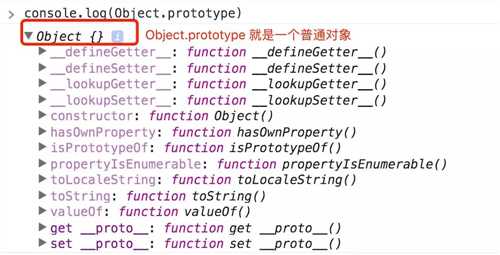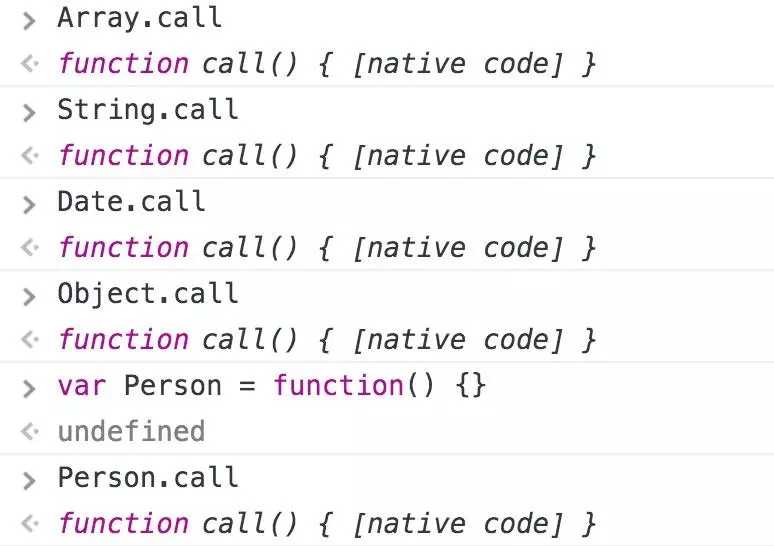标签:其它 reverse 不能 int except erro 不用 function seo
Number.__proto__ === Function.prototype // true
Number.constructor == Function //true
Boolean.__proto__ === Function.prototype // true
Boolean.constructor == Function //true
String.__proto__ === Function.prototype // true
String.constructor == Function //true
// 所有的构造器都来自于Function.prototype,甚至包括根构造器Object及Function自身
Object.__proto__ === Function.prototype // true
Object.constructor == Function // true
// 所有的构造器都来自于Function.prototype,甚至包括根构造器Object及Function自身
Function.__proto__ === Function.prototype // true
Function.constructor == Function //true
Array.__proto__ === Function.prototype // true
Array.constructor == Function //true
RegExp.__proto__ === Function.prototype // true
RegExp.constructor == Function //true
Error.__proto__ === Function.prototype // true
Error.constructor == Function //true
Date.__proto__ === Function.prototype // true
Date.constructor == Function //true
JavaScript中有内置(build-in)构造器/对象共计12个(ES5中新加了JSON),这里列举了可访问的8个构造器。剩下如Global不能直接访问,Arguments仅在函数调用时由JS引擎创建,Math,JSON是以对象形式存在的,无需new。它们的proto是Object.prototype。如下
Math.__proto__ === Object.prototype // true
Math.construrctor == Object // true
JSON.__proto__ === Object.prototype // true
JSON.construrctor == Object //true
上面说的函数对象当然包括自定义的。如下
// 函数声明
function Person() {}
// 函数表达式
var Perosn = function() {}
console.log(Person.__proto__ === Function.prototype) // true
console.log(Man.__proto__ === Function.prototype) // true
这说明什么呢?
** 所有的构造器都来自于 Function.prototype,甚至包括根构造器Object及Function自身。所有构造器都继承了·Function.prototype·的属性及方法。如length、call、apply、bind**
(你应该明白第一句话,第二句话我们下一节继续说,先挖个坑:))
Function.prototype也是唯一一个typeof XXX.prototype为 function的prototype。其它的构造器的prototype都是一个对象(原因第三节里已经解释过了)。如下(又复习了一遍):
console.log(typeof Function.prototype) // function
console.log(typeof Object.prototype) // object
console.log(typeof Number.prototype) // object
console.log(typeof Boolean.prototype) // object
console.log(typeof String.prototype) // object
console.log(typeof Array.prototype) // object
console.log(typeof RegExp.prototype) // object
console.log(typeof Error.prototype) // object
console.log(typeof Date.prototype) // object
console.log(typeof Object.prototype) // object
噢,上面还提到它是一个空的函数,console.log(Function.prototype) 下看看(留意,下一节会再说一下这个)
知道了所有构造器(含内置及自定义)的__proto__都是Function.prototype,那Function.prototype的__proto__是谁呢?
相信都听说过JavaScript中函数也是一等公民,那从哪能体现呢?如下
console.log(Function.prototype.__proto__ === Object.prototype) // true
这说明所有的构造器也都是一个普通 JS 对象,可以给构造器添加/删除属性等。同时它也继承了Object.prototype上的所有方法:toString、valueOf、hasOwnProperty等。(你也应该明白第一句话,第二句话我们下一节继续说,不用挖坑了,还是刚才那个坑;))
最后Object.prototype的proto是谁?
Object.prototype.__proto__ === null // true
已经到顶了,为null。(读到现在,再回过头看第五章,能明白吗?)
在 ECMAScript 核心所定义的全部属性中,最耐人寻味的就要数
prototype属性了。对于 ECMAScript 中的引用类型而言,prototype是保存着它们所有实例方法的真正所在。换句话所说,诸如toString()和valuseOf()等方法实际上都保存在prototype名下,只不过是通过各自对象的实例访问罢了。
——《JavaScript 高级程序设计》第三版 P116
我们知道 JS 内置了一些方法供我们使用,比如:
对象可以用 constructor/toString()/valueOf() 等方法;
数组可以用 map()/filter()/reducer() 等方法;
数字可用用 parseInt()/parseFloat()等方法;
Why ???

var Person = new Object()
Person 是 Object 的实例,所以 Person 继承了Object 的原型对象Object.prototype上所有的方法:

Person.constructor 也可以用 Person.hasOwnProperty。
var num = new Array()
num 是 Array 的实例,所以 num 继承了Array 的原型对象Array.prototype上所有的方法:

Are you f***ing kidding me? 这尼玛怎么是一个空数组???

Object.getOwnPropertyNamesprototy 中的属性,返回一个数组:
var arrayAllKeys = Array.prototype; // [] 空数组
// 只得到 arrayAllKeys 这个对象里所有的属性名(不会去找 arrayAllKeys.prototype 中的属性)
console.log(Object.getOwnPropertyNames(arrayAllKeys));
/* 输出:
["length", "constructor", "toString", "toLocaleString", "join", "pop", "push",
"concat", "reverse", "shift", "unshift", "slice", "splice", "sort", "filter", "forEach",
"some", "every", "map", "indexOf", "lastIndexOf", "reduce", "reduceRight",
"entries", "keys", "copyWithin", "find", "findIndex", "fill"]
*/
这样你就明白了随便声明一个数组,它为啥能用那么多方法了。
细心的你肯定发现了Object.getOwnPropertyNames(arrayAllKeys) 输出的数组里并没有 constructor/hasOwnPrototype等对象的方法(你肯定没发现)。
但是随便定义的数组也能用这些方法
var num = [1];
console.log(num.hasOwnPrototype()) // false (输出布尔值而不是报错)
Why ???

因为Array.prototype 虽然没这些方法,但是它有原型对象(__proto__):
// 上面我们说了 Object.prototype 就是一个普通对象。
Array.prototype.__proto__ == Object.prototype
所以 Array.prototype 继承了对象的所有方法,当你用num.hasOwnPrototype()时,JS 会先查一下它的构造函数 (Array) 的原型对象 Array.prototype 有没有有hasOwnPrototype()方法,没查到的话继续查一下 Array.prototype 的原型对象 Array.prototype.__proto__有没有这个方法。
var f = new Function("x","return x*x;");
//当然你也可以这么创建 f = function(x){ return x*x }
console.log(f.arguments) // arguments 方法从哪里来的?
console.log(f.call(window)) // call 方法从哪里来的?
console.log(Function.prototype) // function() {} (一个空的函数)
console.log(Object.getOwnPropertyNames(Function.prototype));
/* 输出
["length", "name", "arguments", "caller", "constructor", "bind", "toString", "call", "apply"]
*/
我们再复习第八小节这句话:
所有函数对象proto都指向
Function.prototype,它是一个空函数(Empty function)
嗯,我们验证了它就是空函数。不过不要忽略前半句。我们枚举出了它的所有的方法,所以所有的函数对象都能用,比如:

如果你还没搞懂啥是函数对象?

还有,我建议你可以再复习下为什么:
Function.prototype是唯一一个typeof XXX.prototype为 “function”的prototype
我猜你肯定忘了。
第八小节我们总结了:
所有函数对象的 __proto__ 都指向 Function.prototype,它是一个空函数(Empty function)
但是你可别忘了在第三小节我们总结的:
所有对象的 __proto__ 都指向其构造器的 prototype
咦,我找了半天怎么没找到这句话……

我们下面再复习下这句话。
先看看 JS 内置构造器:
var obj = {name: ‘jack‘}
var arr = [1,2,3]
var reg = /hello/g
var date = new Date
var err = new Error(‘exception‘)
console.log(obj.__proto__ === Object.prototype) // true
console.log(arr.__proto__ === Array.prototype) // true
console.log(reg.__proto__ === RegExp.prototype) // true
console.log(date.__proto__ === Date.prototype) // true
console.log(err.__proto__ === Error.prototype) // true
再看看自定义的构造器,这里定义了一个 Person:
function Person(name) {
this.name = name;
}
var p = new Person(‘jack‘)
console.log(p.__proto__ === Person.prototype) // true
p 是 Person 的实例对象,p 的内部原型总是指向其构造器 Person 的原型对象 prototype。
每个对象都有一个 constructor 属性,可以获取它的构造器,因此以下打印结果也是恒等的:
function Person(name) {
this.name = name
}
var p = new Person(‘jack‘)
console.log(p.__proto__ === p.constructor.prototype) // true
上面的Person没有给其原型添加属性或方法,这里给其原型添加一个getName方法:
function Person(name) {
this.name = name
}
// 修改原型
Person.prototype.getName = function() {}
var p = new Person(‘jack‘)
console.log(p.__proto__ === Person.prototype) // true
console.log(p.__proto__ === p.constructor.prototype) // true
可以看到p.__proto__与Person.prototype,p.constructor.prototype都是恒等的,即都指向同一个对象。
如果换一种方式设置原型,结果就有些不同了:
function Person(name) {
this.name = name
}
// 重写原型
Person.prototype = {
getName: function() {}
}
var p = new Person(‘jack‘)
console.log(p.__proto__ === Person.prototype) // true
console.log(p.__proto__ === p.constructor.prototype) // false
这里直接重写了 Person.prototype(注意:上一个示例是修改原型)。输出结果可以看出p.__proto__仍然指向的是Person.prototype,而不是p.constructor.prototype。
这也很好理解,给Person.prototype赋值的是一个对象直接量{getName: function(){}},使用对象直接量方式定义的对象其构造器(constructor)指向的是根构造器Object,Object.prototype是一个空对象{},{}自然与{getName: function(){}}不等。如下:
var p = {}
console.log(Object.prototype) // 为一个空的对象{}
console.log(p.constructor === Object) // 对象直接量方式定义的对象其constructor为Object
console.log(p.constructor.prototype === Object.prototype) // 为true,不解释(?ˇ3ˇ?)
下面这个例子你应该能明白了!
function Person(){}
var person1 = new Person();
console.log(person1.__proto__ === Person.prototype); // true
console.log(Person.prototype.__proto__ === Object.prototype) //true
console.log(Object.prototype.__proto__) //null
Person.__proto__ == Function.prototype; //true
console.log(Function.prototype)// function(){} (空函数)
var num = new Array()
console.log(num.__proto__ == Array.prototype) // true
console.log( Array.prototype.__proto__ == Object.prototype) // true
console.log(Array.prototype) // [] (空数组)
console.log(Object.prototype.__proto__) //null
console.log(Array.__proto__ == Function.prototype)// true
疑点解惑:
Object.__proto__ === Function.prototype // true
Object 是函数对象,是通过new Function()创建的,所以Object.__proto__指向Function.prototype。(参照第八小节:「所有函数对象的__proto__都指向Function.prototype」)
Function.__proto__ === Function.prototype // true
Function 也是对象函数,也是通过new Function()创建,所以Function.__proto__指向Function.prototype。
自己是由自己创建的,好像不符合逻辑,但仔细想想,现实世界也有些类似,你是怎么来的,你妈生的,你妈怎么来的,你姥姥生的,……类人猿进化来的,那类人猿从哪来,一直追溯下去……,就是无,(NULL生万物)
正如《道德经》里所说“无,名天地之始”。
Function.prototype.__proto__ === Object.prototype //true其实这一点我也有点困惑,不过也可以试着解释一下。
Function.prototype是个函数对象,理论上他的__proto__应该指向Function.prototype,就是他自己,自己指向自己,没有意义。
JS一直强调万物皆对象,函数对象也是对象,给他认个祖宗,指向Object.prototype。Object.prototype.__proto__ === null,保证原型链能够正常结束。
__proto__ 而非prototype
要深入理解这句话,我们再举个例子,看看前面你真的理解了吗?
var animal = function(){};
var dog = function(){};
animal.price = 2000;
dog.prototype = animal;
var tidy = new dog();
console.log(dog.price) //undefined
console.log(tidy.price) // 2000
这里解释一下:
var dog = function(){};
dog.prototype.price = 2000;
var tidy = new dog();
console.log(tidy.price); // 2000
console.log(dog.price); //undefined
var dog = function(){};
var tidy = new dog();
tidy.price = 2000;
console.log(dog.price); //undefined
这个明白吧?想一想我们上面说过这句话:
实例(
tidy)和 原型对象(dog.prototype)存在一个连接。不过,要明确的真正重要的一点就是,这个连接存在于实例(tidy)与构造函数的原型对象(dog.prototype)之间,而不是存在于实例(tidy)与构造函数(dog)之间。
聪明的你肯定想通了吧
标签:其它 reverse 不能 int except erro 不用 function seo
原文地址:https://www.cnblogs.com/niuzijie/p/11262007.html